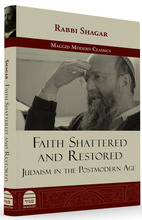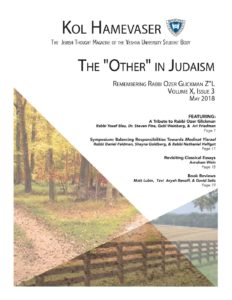Personalized Prayer
Few can question that tefilla in our communities is seriously lacking. Our shuls leave us with davening that is too often, even at its best, rushed and uninspiring. At its worst, the experience can be downright painful to hear off-key mispronunciations of Hebrew and to witness the rampant talking and disrespect for what should be avoda she-beleiv. Ask high school educators and you are likely to hear that they dread tefilla and the enforcement of what so many students find meaningless. As high-schoolers mature and develop, both intellectually and spiritually, and even when they return from Israel with a more intense approach to Torah and mitzvot, too often this does not translate into a more meaningful tefilla. Therefore, it is no wonder that Yeshiva University is constantly experimenting with minyan times and locations; the most popular minyanim on campus are the most rushed.
There have been many significant attempts at improving tefilla in our communities. Sadly, they have largely failed. While new siddurim are published with the aim of adding insight and profundity to our davening, most often these are not read, and if read, they don’t improve the tefilla experience. As Rabbi Shalom Carmy notes regarding tefilla, quoting the legendary gaon Yogi Berra, “You can’t think and hit at the same time.” In other words, one cannot learn about tefilla and daven at the same time. New siddurim are often left to adorn our bookshelves with their beautiful covers but do not do much to transform our prayer. Music has been added to many tefillot, particularly Kabbalat Shabbat, in an effort to engage more mispallelim in sincere prayer. Leaving aside the problematic name for these tefilla services, in practice they enhance only prayers of secondary importance. Kabbalat Shabbat may be very beautiful, but subsequently, during ma’ariv, the shemone esreh, which is meant to be the spiritual apex of prayer, remains uninspired and rushed. In contrast to the communal involvement experienced during Kabbalat Shabbat, ma’ariv lags behind, and tefilla, in its pure form, remains lax.
So what, if anything, can be done? I would argue that we need to shift the way we teach and educate about tefilla. Too often, the focus is on the importance of the words themselves. However, students are never trained to go beyond the text and are never introduced to the opportunity to personalize their prayers.
In Parshat VaYechi, Yakov Avinu tells Yosef “Va-Ani hineh natati lekha shekhem ehad al ahekha, asher lakakhit mi-yad ha-emori be-charbi u-bekashti.”[1]
Yosef was given a double portion including Shechem, which Yakov took from the Emori with his sword and bow. In our standard versions of Onkelos, this verse is interpreted not as a physical sword and bow but rather as to two terms for prayer: tseloti and ba’uti. These two terms for prayer are often assumed to be synonymous but, in reality, they are quite different. Tseloti refers to the common prayers that everyone says. Ba’uti however, refers to supplication, to the personal requests that an individual can add during his or her prayers (See Avoda Zara 8a). These additional prayers are not referred to with the sword metaphor, but with the metaphor of a bow. Unlike a sword that can be effective whether or not the holder is skilled, a bow changes in effectiveness based on the skill of the holder. Great expertise is needed to properly ascertain the force with which one pulls the bowstring and the proper angle at which to hold the bow. It is the effect of the bow, not the sword, that varies based on the skill of the holder. Therefore, the personal prayers added by the individual to reflect the deepest recesses of his or her heart are characterized as kashti, a bow.
To my mind, we make a mistake by only focusing on the fixed nature of prayer and ignoring its personalized supplicatory nature. Students don’t find prayer inspiring because they don’t find it personal. As adults, we never learned how and when to add our personal needs to tefilla. Interestingly, in Rav Soloveitchik’s essay Ra’ayonot al Ha-Tefilla,[2] he speaks of the personal supplicatory, individual nature of tefilla. The Rav describes how tefilla is meant to reflect the crises which lie at the depths of an individual’s soul. He speaks about the personal needs that one is meant to convey in tefilla; of how an individual is supposed to go through profound soul searching in prayer. Our failure to convey the difference between my tefilla and your tefilla, our inability as educators to open our souls and share with our students what we pray for, may actually impede our community’s ability to improve the sincerity and devotion of our prayers.
Rabbi Ezra Schwartz is a Rosh Yeshiva and the Associate Director of RIETS. He also serves as the Rabbi of the Mount Sinai Jewish Center in Washington Heights.
[1] Bereishit 48:22.
[2] Joseph B. Soloveitchik, “Ra’ayanot al haTefilla,” HaDarom 47 (1979), 84-106.




